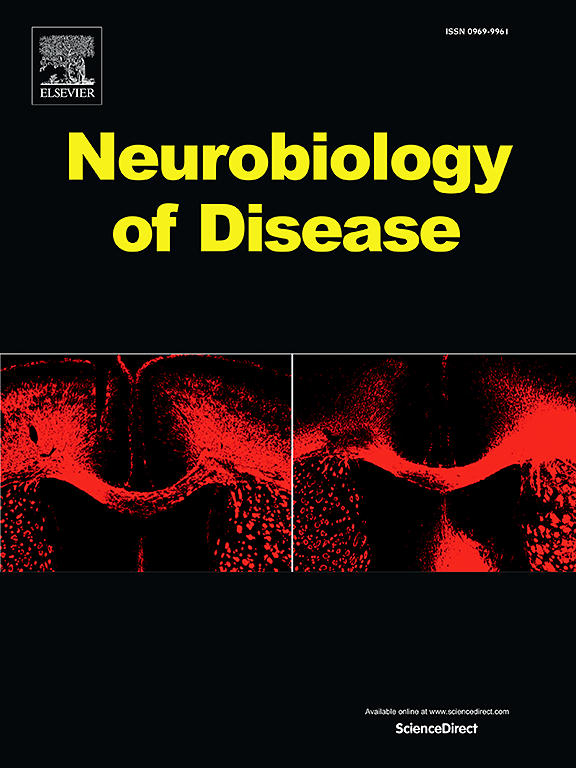ApoE等位基因变异在脑内Aβ沉积形成中的比较。
IF 5.6
2区 医学
Q1 NEUROSCIENCES
引用次数: 0
摘要
载脂蛋白E (APOE)亚型APOE2, APOE3和APOE4对阿尔茨海默病(AD)风险的差异调节。尽管已有证据表明APOE对Aβ沉积有影响,但APOE基因型对不同形式淀粉样蛋白病理的不同影响仍知之甚少。大脑中淀粉样蛋白病理的三种主要类型是致密核纤维斑块、弥漫性Aβ沉积和以脑淀粉样血管病(CAA)形式出现的血管沉积,它们的相对分布被认为是决定AD和相关痴呆表型结果的重要因素。在这里,我们使用不同的ad -淀粉样变性小鼠模型来提出两个主要问题:(1)人类APOE4是否促进所有这些淀粉样蛋白病理学亚型的沉积,以及(2)APOE4的存在是否影响弥漫性Aβ沉积向密集核心神经斑块的形态转变?在SAA-APP敲入模型中,我们观察到人类Apoe的交叉减少了淀粉样蛋白的负担。在三个人类APOE等位基因中,在SAA-APP小鼠中,相对于APOE3和APOE2, APOE4产生的斑块负担和大小最高。尽管所有三种人类APOE亚型与单个斑块的共定位水平相当,但在病理早期阶段的集中基因组分析显示,与人类APOE3相比,人类APOE4小鼠的神经连接通路受到影响,这暗示了早期神经元功能障碍的机制。在以弥漫性Aβ沉积和老年出现的脑淀粉样血管病(CAA)为特征的缓慢发展的APPsi模型中,我们还发现小鼠Apoe表现出最大的淀粉样蛋白负荷,其次是人类APOE4和APOE3。在携带小鼠Apoe或人类APOE4小鼠的老年APPsi小鼠中发现CAA沉积,但在携带人类APOE3的APPsi小鼠中很少发现。最后,与APOE3小鼠相比,APOE4在APPsi小鼠的新生Aβ种子中发现,APOE4加速了实质Aβ沉积,尽管APOE4存在下的种子没有改变固有的弥漫形态的Aβ沉积。总的来说,这些结果表明APOE基因型影响所有类型淀粉样蛋白病理的沉积,包括致密核、弥漫性和血管病理。值得注意的是,APOE变异只改变了淀粉样蛋白的数量,而每种模型中固有的淀粉样蛋白病理类型并未改变。总之,这些发现暗示了apoE作为所有类型的a β沉积的修饰剂的关键作用,其修饰斑块压实或形态的潜力有限。本文章由计算机程序翻译,如有差异,请以英文原文为准。
Comparison of the ApoE allelic variants in the formation of intracerebral Aβ deposits
The Apolipoprotein E (APOE) isoforms APOE2, APOE3 and APOE4 differentially modulate risk of Alzheimer's disease (AD). Despite established evidence for APOE's impact on Aβ deposition, the differential effects of APOE genotypes on distinct forms of amyloid pathology remain poorly understood. The three primary types of amyloid pathology in the brain are dense-cored fibrillar plaques, diffuse Aβ deposits, and vascular deposits in the form of cerebral amyloid angiopathy (CAA) and their relative distribution is thought to be important in determining the phenotypic outcomes in AD and related dementias. Here, we used different mouse models of AD-amyloidosis to ask two main questions: (1) does human APOE4 promote the deposition of all these subtypes of types of amyloid pathology, and (2) does presence of APOE4 influence the morphological transformation of diffuse Aβ deposits into dense-core neuritic plaques? In the SAA-APP knock-in model of dense-cored Aβ deposits resulting from accumulation of protofibrillar-favoring Aβ42, we observed that crossing in human APOE reduced amyloid burden. Among the three human APOE alleles, APOE4 produced the highest plaque burden and size, relative to APOE3 and APOE2 in the SAA-APP mice. Though all three human APOE isoforms showed comparable levels of colocalization with individual plaques, focused genomic analysis at early stages of pathology revealed that neural connectivity pathways were affected in mice with human APOE4 compared to human APOE3, implicating mechanisms of early neuronal dysfunction. In the slowly-developing APPsi model, characterized by predominantly diffuse Aβ deposits and cerebral amyloid angiopathy (CAA) emerging at older ages, we also found that mouse Apoe showed the greatest amyloid burden, followed by human APOE4 and APOE3. CAA deposition was noted in aged APPsi mice with mouse Apoe or human APOE4 mice but rarely in APPsi mice with human APOE3. Finally, neonatal Aβ seeding in APPsi mice revealed that APOE4 accelerated parenchymal Aβ deposition compared to APOE3 mice, though seeding in the presence of APOE4 did not alter the inherent diffuse morphology of the Aβ deposits. Collectively, these results demonstrate that APOE genotype influences the deposition of all types of amyloid pathology, including dense-cored, diffuse and vascular pathology. Notably, only the amount of amyloid was modified by APOE variants, while the type of amyloid pathology inherent in each model was not altered. Together these findings implicate a key role for apoE as a modifier of all types of Aβ deposition with limited potential to modify plaque compaction or morphology.
求助全文
通过发布文献求助,成功后即可免费获取论文全文。
去求助
来源期刊

Neurobiology of Disease
医学-神经科学
CiteScore
11.20
自引率
3.30%
发文量
270
审稿时长
76 days
期刊介绍:
Neurobiology of Disease is a major international journal at the interface between basic and clinical neuroscience. The journal provides a forum for the publication of top quality research papers on: molecular and cellular definitions of disease mechanisms, the neural systems and underpinning behavioral disorders, the genetics of inherited neurological and psychiatric diseases, nervous system aging, and findings relevant to the development of new therapies.
 求助内容:
求助内容: 应助结果提醒方式:
应助结果提醒方式:


